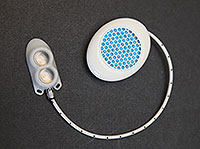The artificial pancreas
 For these reasons, it would be useful if the guesswork could be taken out of the medication problem by having a system that would make the automatic adjustments needed. This would have the role of an “artificial pancreas”, otherwise known as a “closed loop” insulin delivery system. Many attempts have been made to achieve this, including pancreas transplants and electronic sensor-linked insulin pumps but there are no routine methods.
For these reasons, it would be useful if the guesswork could be taken out of the medication problem by having a system that would make the automatic adjustments needed. This would have the role of an “artificial pancreas”, otherwise known as a “closed loop” insulin delivery system. Many attempts have been made to achieve this, including pancreas transplants and electronic sensor-linked insulin pumps but there are no routine methods.
At present, for insulin users, non-automatic insulin pumps are available, although not common in the UK. While not ideal, for many people, they might represent an improvement on injection and in concept, they could be thought of as a good stepping-stone to an automated system.
Researchers within our Leicester School of Pharmacy in the Health and Life Sciences Faculty, have for some time been researching a novel automated system and in 2008 received NEAT (NHS) funding for three years to develop it further.
The stated aim of the project was to develop a cost-effective, safe, implantable and refillable device that will hold several weeks’ insulin supply at a time and make automatic adjustments for the insulin dose needed to control blood glucose levels. The results were extremely encouraging and late in 2011 we were able to show real success.
The device will not be ready for patient use for some years to come but the next stage is focused on getting the design right and the performance proved to make sure that the device is a feasible and attractive alternative to conventional treatment.
We have just received additional funding (from the Edith Murphy Foundation charity) to help with this. In the meantime, while continuing with the development of this design, we have widened the sphere of enquiry to find out more about the physiological needs of diabetic people and how they use their calories.